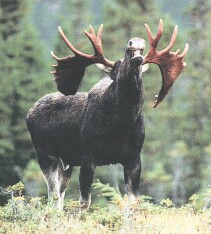The moose is the largest member of the deer family, Cervidae. Its genus/species within that family is Alces alces, and there are subspecies of moose based on location: there is Alaska's Alces alces gigas, as well as the Canadian and American Alces alces americanus, and the European Alces alces machlis. Regardless of where they live, moose are herbivores, and ruminants, which means they eat vegetation (up to 10 kg per day) and digest it in multiple stomachs (four of them), regurgitating partially digested food to rechew it, like a cow. They are also crepuscular, which means they are most active at twilight. Height at the shoulders for an average moose is about 2 metres. Only the males have antlers, which are large and relatively flat. These antlers can have as many as 30 spikes, and their shape and distribution differs from animal to animal. Males, or 'bulls', shed their antlers once a year in early winter. New ones form in the spring; they're living tissue, nourished by blood vessels, and covered with a soft skin called 'velvet'. Eventually the inner tissue becomes a hard, bony extension of the skull, the velvet gets scraped off, and the antlers become solid and hard. Their main function is for display during the mating season (called the 'rut'), and dominance within the herd. Moose mothers are extremely aggressive, as are males in rut. Moose in general tend to be solitary animals, and if they travel in groups, it's usually ones with just a few adults. How much area a group of moose will claim depends on the availability of food and the climate, as well as the nature of the terrain. In Newfoundland, where the density of moose is as high or higher than anywhere else in the world, there are an average of 6 to 8 moose per square kilometre of woodland. That's a lot of moose! Other than man, who kills moose for sport, for meat, and by accident on the highways, the moose's main predator is the wolf. The wolf's constant attention keeps the moose herds healthy, by killing the weak and injured ones. Unless overhunted, moose do very well in the wilderness areas of North America. In fact, in many areas, hunting is a necessary measure to keep moose populations in check. Moose are not native to Newfoundland, for example; four were released in 1904 to supplement dwindling caribou herds, (Canadian Geographic, December 2000), and there are now an estimated 125,000 to 150,000 moose in that province! Moose on the highways in wilderness areas of North America pose a definite hazard, and are responsible for a lot of damage to vehicles and injuries to people, resulting in substantial repair and health insurance costs in some regions. Possible solutions that have been proposed include planting the sides of the road with vegetation that moose do not like to eat, and spraying the shoulders of the road with artificial wolf urine.
|
